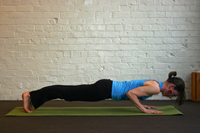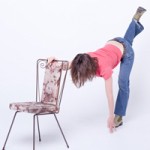by Kara-Leah Grant
Chaturanga Dandasana is one of those postures that we often don’t spend time in – either in yoga class or in our home yoga practice. It’s a one-breath wonder. We’re in, we’re moving out, that’s it.
Partly this is because it’s a challenging posture and we usually want to get out of it as soon as possible. And part of it is because it’s not a flashy yoga posture where we feel like we get somewhere or gain a lot over time.
It’s easy to see Chaturanga Dandasana as just a transition posture. Something we do to get somewhere else.
In doing so, we risk short-changing our practice and injuring our body. While it may not require great flexibility, chaturuanga dandasana still requires the right alignment so we don’t injure our body by repeatedly putting it under unnecessary stress and strain.
One of my favourite ways to start with this posture is to do it standing up.
Yes, that’s right, try Chaturanga Dandasana standing up.
Bring yourself into Tadasana (Mountain Pose) and then hug your biceps and triceps into your body and lift your palms up flat in front of you.
Because there’s no weight-bearing involved, you can take time to explore what’s happening in the shoulder girdle, and what is going on through the spine, pelvis and legs.
With the hands lifted in front of you, round your shoulders and see what that feels like. Open your palms out sideways and note how it affects your shoulder blades. Keep your shoulder blades hugging against your spine and bring your palms back in line with your body.
This helps you to understand and feel from the inside out how the muscles of the back and shoulder area are activated, how the arms are activated, and what needs to line up.
Go through this a few times – widening the hands and bringing them back in and feeling what’s going on in the shoulders. You can then note how your shoulders move and if they are open enough to roll back and down in this posture.
After playing with the alignment of the hands, arms and shoulders in chaturunga dandasana, it’s time to hit the ground and put it into action.
When it’s done correctly, chaturunga dandasana is a light posture. It’s easy to maintain for many minutes at a time – and this has nothing to do with brute strength at all. It’s all about activating the energy within the pose correctly.
So how do you do that?
At this point, I suggest starting with a knees-down variation of chaturanga dandasana.
This helps support the pelvis and spine, and is actually a more difficult variation to find alignment in. It’s much easier to align the spine, pelvis and legs when the knees are lifted.
It’s an important point to note in yoga – sometimes, the variations are more difficult because they require us to be more present than the full expression of the posture.
Using knees -down is a way to work safely in the posture. The key is to actively press down through the hands into the floor. So even though you’re lowering yourself to the ground, you’re also pressing the ground firmly away from you as if you want it to go away. This is what holds you up even as you lower down.
Be mindful of the alignment of the pelvis. You want to think about lengthening the spine – so lengthen your tailbone towards your heels. Notice how that naturally begins to create an engagement through the lower belly muscles, and hold that core strength.
Practice lowering yourself at an even-paced exhale all the way down to the ground, while keeping a straight diagonal line from shoulders to knees. Hug the elbows to the body and keep the shoulder-blades hugging the spine and drawn down toward the tailbone – just like you did while standing.
Once you can strongly lower yourself all the way to the ground without collapsing and without sagging through the pelvis, then you’re ready to explore a full variation of chaturunga dandasana.
From a standing forward bend (uttanasana), walk your feet back until you’re in a high press-up position (plank pose). Your hands are directly underneath your shoulders and your shoulder-blades are drawn against the spine and down toward the tailbone.
Here’s the key aspects for maintaining integrity and strength in chaturunga dandasana:
- Press firmly down through the hands, pressing the ground away from you.
- Press down through the balls of your feet
- Press your heels back towards an invisible wall behind you.
- Lengthen the crown of the head forward.
- Extend your tailbone towards your heels.
- Engage your lower belly.
- Engage your thighs.
- Continue to hug arms to body and shoulderblades to spine.
Yes, there’s a whole lot going on – but this isn’t so much about strength as it is about energy.
1 & 2 create a relationship with the ground where you are actively pressing it away from you. This provides lift and support for your entire body. You’re creating a relationship with the energy arising from the earth – and that’s far more powerful than your muscles ever will be.
3, 4 & 5 create an integrated line of energy from heels to crown of head. It’s important to get the pelvis in the right place here to keep that line of energy unbroken. If your pelvis is out of alignment, you’ll break the flow and feel a dropping or sagging through the midline. Orientate your pelvis correctly, and you’ll begin to feel like you’re flying.
6 & 7 support the integrity of the energy line you’re accessing from heels to crown of head. They happen automatically when you get that line right. If the energy line isn’t quite activated, engaging through the thighs and lower belly can help align it.
8 is vital for maintaining the posture. You need to keep the chest area open and free, and you do this by hugging the shoulder blades against the spine. Support on the back of the body frees the front up to open.
Once you can hold a full chaturunga dandasana for an easy five breaths, then begin to lower yourself toward the ground – either all the way down, or down into a hover position (see photo above).
Nothing changes in your align as you lower yourself. The body stays rock solid and straight like a staff, the chest stays open, the shoulder blades continue to hug the spine.
You continue to:
- press down through the hands and balls of feet,
- press back through the heels,
- extend through the crown, and
- extend through the tailbone.
It’s that activation of pressing and extension which provides you with the lift to fly. Then Chaturanga Dandasana stops being a chore and starts feeling amazing. Trust me 🙂
PS. Strictly speaking, the high press-up position is called Plank Pose, and the low hovering position (see photo above) is called Chaturanga Dandasana. But mostly what we’re learning to do is transition from one to the other seamlessly.


So where did this popular sequence come from? The oldest-known yoga text to describe the Sun Salutation sequence, the Yoga Makaranda, was written in 1934 by T. Krishnamacharya, who is considered by many to be the father of modern hatha yoga. It is unclear whether Krishnamacharya learned the sequence from his teacher Ramamohan Brahmachari or from other sources, or whether he invented it himself. In The Yoga Tradition of the Mysore Palace, yoga scholar N.E. Sjoman identifies an earlier text called the Vyayama Dipika (or “Light on Exercise”) that illustrates athletic exercises for Indian wrestlers, including some that are strikingly similar to Krishnamacharya’s version of Surya Namaskar.
“Certainly, modern asana practice—and Surya Namaskar, after it was grafted on to it—is an innovation that has no precedent in the ancient Indian tradition, but it was rarely formulated as ‘mere gymnastics,'” says Mark Singleton, author of Yoga Body: The Origins of Modern Posture Practice. “More often, it was conceived within a religious [Hindu] framework, and was seen as a spiritual expression as well as a physical one. But in modern India, for many people, it made complete sense for physical training to be conceived as a form of spiritual practice, with no contradiction implied.”
So, it appears that Krishnamacharya was influenced by both athletics and spiritual practice, and it was the emphasis he placed on the breath and on devotion that set his teaching of yoga asana apart from a purely athletic endeavor. According to Mohan, co-author (with his father, A.G. Mohan) of the forthcoming From Here Flows the River: The Life and Teachings of Krishnamacharya, it was the attitude of Surya Namaskar that Krishnamacharya cared about. Whether he was teaching the Vedic mantras or the sequence of postures, the intention was the same. “One is offering salutation to the Divine, represented by the sun, as a source of light removing the darkness of a clouded mind and as a source of vitality removing the diseases of the body,” says Mohan.
Krishnamacharya taught the sequence to his students, including K. Pattabhi Jois (founder of the Ashtanga Yoga system), B.K.S. Iyengar (founder of the Iyengar Yoga system), and Indra Devi (recognized as the first Western woman to teach yoga around the world). These students went on to become internationally prominent teachers and to inspire much of the practice in the West. As a result, Sun Salutations became an integral part of our modern practice.
Reference http://www.yogajournal.com/practice/2746
Hey David,
Thanks for all the info – it’s fascinating to delve into the history of it all.
Nice article and demo Kl and Seka. One thing I have found with this pose is that the instruction to “hug the elbows to the side body” can be taken too literally for some students. They end up over using their rhomboids and get that awful valley dipping between the shoulder blades. So I cue them instead to hug the armpits to the side body with less focus on the elbows. To me this encourages equal use of serratus anterior and rhomboids so they get really good shoulder stability and no winging or dipping.
Another cue I use to keep the ribs from flaring is is draw the ribcage towards the hips. In my experience students tend to find this easier than the instruction to “take the ribs back”.
I’m glad you chose chaturanga dandasana because as you said KL, it is an asana that is done often and quickly. Long term injuries do happen so breaking it down is really beneficial. Thanks. jude
Hey Jude,
Oh I love hearing of alternate ways to cue movement – thank you so much for this! I like that sensation of hugging the armpits. I’m going to play with it with my yoga students and see how they find it.